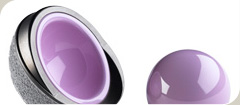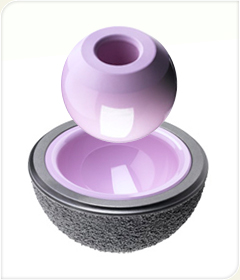Ceramic on Ceramic
The bearing surface is all important. The frictional forces are dependent on the surface roughness and the chemical composition of the material. Lubrication reduces friction, which reduces wear and optimum ‘joint’ motion occurs when there is a fluid film between hard on hard bearings, in this case, ceramic on ceramic (CoC).
Ceramics are hydrophilic and permit better ‘wettability’ of the surface, which ensures that a fluid is uniformly distributed over the bearing surface.
Ceramics have an extremely low wear rate - near zero wear - compared with conventional polyethylene. Ceramic is second only to diamonds in hardness and is stable and chemically inert. It has twice the hardness of stainless steel and is resistant to scratching. However, it is a brittle material and fracture of the ceramic liner in a metal shell, or ceramic head remains a possibility, but the risk is small. The overall fracture rate reported in the literature is around 0.004% (4 in 100,000), compared with the fracture rate of femoral stems, which is 0.27% (270 in 100,000).
Ceramics are available from a limited number of manufacturers as the quality of this material is dependent on a rigorous manufacturing process. At the time of writing, elevated liners were not available, which may potentially increase the risk of dislocation.
Ceramic bearing surfaces were first utilised in hip replacements by Pierre Boutin Pau in France in 1970. New composite ceramics such as Biolox and Delta are associated with less crack propagation and fracture potential. The head size can be increased (to 36mm) when articulating with an average sized socket.
The problem of a noise - squeaking - emanating from the ‘hip joint’ with CoC bearings is well documented in the literature. However, squeaking is not exclusive to ceramic couples and can occur with all bearing surfaces.
With the development of composite ceramics, it is likely that the surgeon will be able to use even bigger head sizes, thus further reducing the risk of dislocation.
Bio-compatibility of ceramics is better than metal on metal or metal on polyethylene bearing surfaces. No toxicity or hypersensitivity reactions have been revealed and there is minimal tissue reaction. Osteolysis has been documented, but no chromosomal aberrations or carcinogenic changes have been triggered by such bearing surfaces.



